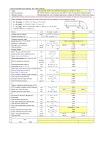Capillary tube is a pressure reducing device to meter the flow of refrigerant from the condenser outlet to the evaporator inlet in compression-type refrigeration systems.Capillary tubes are used instead of thermal expansion valves.The length and diameter of the capillary tube is chosen to match the flow capacity of the tube to the pumping capacity of the compressor.
Basically a capillary tube is a long, narrow tube of constant diameter. The word “capillary” is a misnomer since surface tension is not important in refrigeration application of capillary tubes. Typical tube diameters of refrigerant capillary tubes range from 0.5 mm to 3 mm and the length ranges from 1.0 m to 6 m. Capillary tubes acts as a constant throttle on the system.
The inside diameter of capillary tubes is as small as 0.02 in. (50 mm). Dealing with such small diameters can lead to blockage if large particles reach the tube.
If the tube does become blocked, then the evaporator becomes starved. The suction pressure drops, less refrigerating effect takes place, and the compressor is forced to work harder, resulting in increased head pressures with accompanying increases in temperature.
How does it works ?
Depending on the system design and usage, there is varying mixture refrigerant and oil entering the capillary. The refrigerant may consist of straight liquid or liquid vapor mixture at the inlet.

This mixture enters at high pressure, travels in the capillary, losing pressure due to resistance in the cap tube. As the pressure on the refrigerant decreases, its boiling point also decreases. The tube is filled with vapor and liquid mixture of various density and related speed through the tube.
As this mixture enters the evaporator, the majority of the now low pressure liquid flashes into vapor. As any liquid is left, it rapidly evaporates, usually in the first third or quarter of the evaporator. This now relatively dense low pressure vapor moves through the evaporator picking heat up as it goes, I.e., it is cooling the coil.
Advantages and Disadvantages of Capillary Tubes
Some of the advantages of a capillary tube are:-
1. It is inexpensive.
2. It does not have any moving parts hence it does not require maintenance
3. Capillary tube provides an open connection between condenser and the evaporator hence during off-cycle, pressure equalization occurs between condenser and evaporator.
4. Ideal for hermetic compressor based systems, which are critically charged and factory assembled.
b.Some of the disadvantages of the capillary tube are:-
1. It cannot adjust itself to changing flow conditions in response to daily and seasonal variation in ambient temperature and load. Hence, COP is usually low under off design conditions.
2. It is susceptible to clogging because of narrow bore of the tube, hence, utmost care is required at the time of assembly. A filter-drier should be used ahead of the capillary to prevent entry of moisture or any solid particles
3. During off-cycle liquid refrigerant flows to evaporator because of pressure difference between condenser and evaporator. The evaporator may get flooded and the liquid refrigerant may flow to compressor and damage it when it starts. Therefore critical charge is used in capillary tube based systems. Further, it is used only with hermetically sealed compressors where refrigerant does not leak so that critical charge can be used. Normally an accumulator is provided after the evaporator to prevent slugging of compressor.
1. It is inexpensive.
2. It does not have any moving parts hence it does not require maintenance
3. Capillary tube provides an open connection between condenser and the evaporator hence during off-cycle, pressure equalization occurs between condenser and evaporator.
4. Ideal for hermetic compressor based systems, which are critically charged and factory assembled.
b.Some of the disadvantages of the capillary tube are:-
1. It cannot adjust itself to changing flow conditions in response to daily and seasonal variation in ambient temperature and load. Hence, COP is usually low under off design conditions.
2. It is susceptible to clogging because of narrow bore of the tube, hence, utmost care is required at the time of assembly. A filter-drier should be used ahead of the capillary to prevent entry of moisture or any solid particles
3. During off-cycle liquid refrigerant flows to evaporator because of pressure difference between condenser and evaporator. The evaporator may get flooded and the liquid refrigerant may flow to compressor and damage it when it starts. Therefore critical charge is used in capillary tube based systems. Further, it is used only with hermetically sealed compressors where refrigerant does not leak so that critical charge can be used. Normally an accumulator is provided after the evaporator to prevent slugging of compressor.








-page-001.jpg)




0 Comments